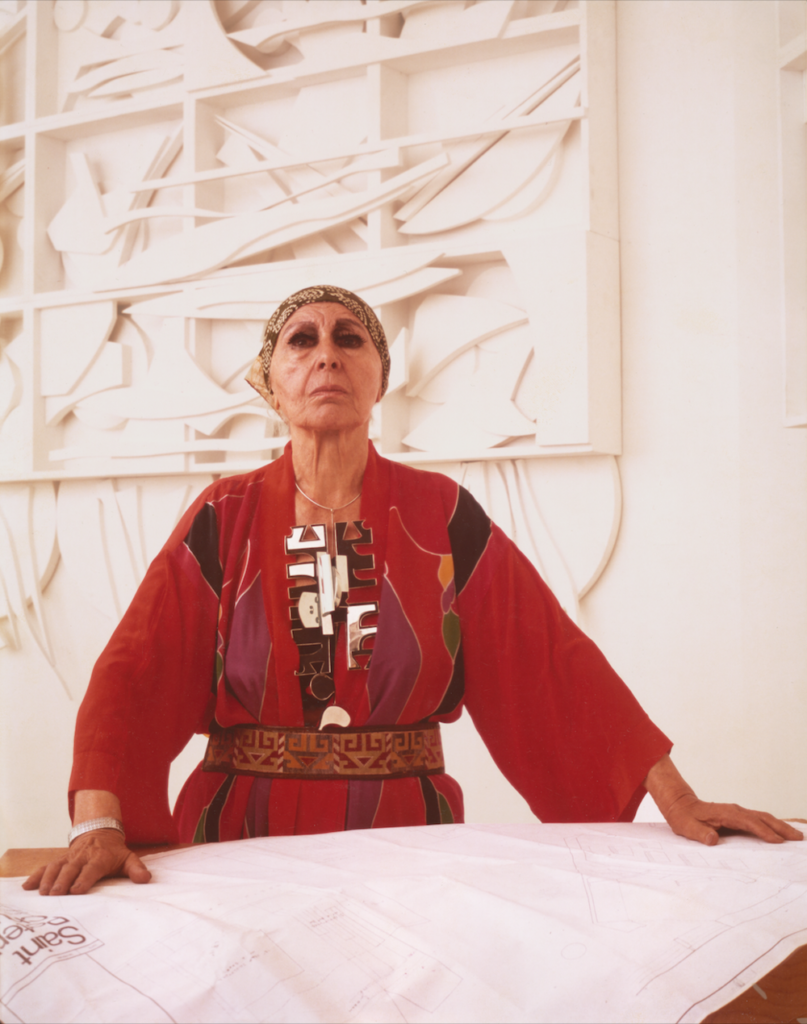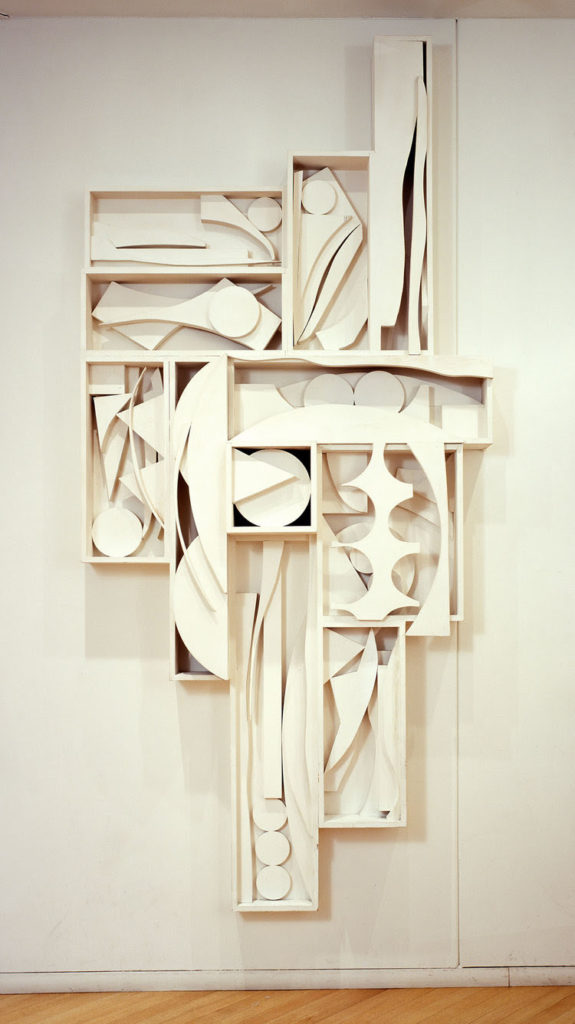Tuesday, February 2, 2021 – ABSTRACT ART IN MANY FORMS FROM LOUISE NEVELSON


TUESDAY, FEBRUARY 2, 2021
The
276th Edition
From Our Archives
LOUISE NEVELSON
NEW YORK ARTIST
AT THE SMITHSONIAN AMERICAN ART MUSEUM

Courtesy National Portrait Gallery, Smithsonian Institution.
Born in Russia, brought to Maine in 1905, lived in New York City starting in 1920. Internationally famous artist who created striking assemblages of found wooden forms, and sculptures in steel, aluminum, Plexiglass, and other materials. Her etchings are not as widely known.
Charles Sullivan, ed American Beauties: Women in Art and Literature (New York: Henry N. Abrams, Inc., in association with National Museum of American Art, 1993)
Nevelson came to the United States as a child with her family, settling first in Rockland, Maine. At age twenty she went to New York to study voice and drama as well as painting and drawing. She attended the Art Students League in 1929 and 1930, then traveled to Munich to study with Hans Hofmann. Two years later she was working as an assistant to Diego Rivera, who introduced her to pre-Columbian art; her first solo show in 1941 featured terra cotta and wood sculptures based on Mayan and other primitive imagery. Not until the mid 1950s did Nevelson’s far-ranging interests coalesce into dramatically conceived constructions for which she became world-renowned. Nevelson’s sculptures are about myth and mystery, and although she took motifs from the world around her, she stated that she identified with ideas “more than with nature.” Although she was fascinated with the living quality of wood, in the 1960s she added plastics and formica to her repertoire of media and in the 1970s began to create monumentally scaled pieces in aluminum and steel.
Virginia M. Mecklenburg Modern American Realism: The Sara Roby Foundation Collection (Washington, D.C.: Smithsonian Institution Press for the National Museum of American Art, 1987)
Louise Nevelson remembered painting, drawing, and carving soap sculptures when she was only five years old. Born in Russia, she moved with her family to Rockland, Maine, in 1905. She felt like an outsider while growing up and apart from her art classes, she did not enjoy being in school. She married Charles Nevelson in 1920 and moved with him to New York. The marriage did not last, however, and Louise left her husband and son to go to Germany, where she worked with abstract expressionist painter Hans Hofmann. She returned to New York after only a few months, feeling a strong connection to the country of her youth and seeing far greater possibilities for the development of her work: “I could be a leaf on the tree in Paris, but I could be the whole tree in America.” Nevelson struggled to gain recognition for many years but eventually achieved success during the 1950s, creating dreamlike constructions that evoked dramatic cityscapes. She built boxes and walls from dismantled furniture, ornaments, and scraps of wood that she found on the street, and often painted them in single colors to emphasize the effects of light and shadow.

Louise Nevelson, Three Nudes, n.d., pen and sepia ink on paper, Smithsonian American Art Museum, Gift of Emil J. Arnold, 1967.56.4

Louise Nevelson, Dawnscape, 1975, cast paper relief, Smithsonian American Art Museum, Museum purchase, 1978.25

Louise Nevelson, Untitled, from the portfolio The New York Collection for Stockholm, 1973, color screenprint on paper, Smithsonian American Art Museum, Gift of the Woodward Foundation, 1976.108.126, © 1973, Louise Nevelson

Louise Nevelson, (Untitled #1), 1973, color aquatint and collage on paper, Smithsonian American Art Museum, Museum purchase, 1973.181

- Louise Nevelson, Night Leaf, 1969, plexiglas, Smithsonian American Art Museum, Gift of the Woodward Foundation, 1976.108.90
- In the late 1960s, Louise Nevelson experimented with new techniques and materials, developing work in Plexiglas and Cor-Ten steel. Night Leaf displays an arrangement of opaque black boxes that contain variations of a simple leaf shape. Nevelson emphasized the contrast between nature and technology by using industrial techniques to illustrate an organic form. The rigid plastic transforms the leaf into a geometric and uniform shape, highlighted by the use of black.
“Sometimes it’s the material that takes over; sometimes it’s me that takes over. I permit them to play, like a seesaw. I use action and counteraction, like in music, all the time …” Louise Nevelson, “American Artists on Art,” 1982

Louise Nevelson, Untitled, 1967, lithograph, Smithsonian American Art Museum, Gift of the Tamarind Lithography Workshop, Inc., 1973.97

Louise Nevelson, Untitled, 1963, transfer lithograph on paper, Smithsonian American Art Museum, Gift of June Wayne, 1991.179.11, © 1963, Louise Nevelson

Louise Nevelson, Untitled (Tamarind no. 830 (830b)), 1963, color lithograph on paper, Smithsonian American Art Museum, Museum purchase, 1971.84.213

- Louise Nevelson, Gate V, from the Garden Gate Series, 1959-1960, cast bronze, Smithsonian American Art Museum, Gift of Mr. and Mrs. David K. Anderson, Martha Jackson Memorial Collection, 1980.137.84
- The illusion of timeworn wood conveyed by the cast bronze of Gate V suggests a once beautiful garden that is now overgrown and wild. It also creates an awareness of the past that is at the heart of Nevelson’s “resurrection” of discarded materials. Nevelson viewed gates and doorways as metaphors that suggest transition in nature and in life. As she explained it, “After a tree is cut down, it is assumed that the tree is dead. It may be the finish of that life as such. But even [then], there’s activity.…Patterns of life change, but life doesn’t change

Louise Nevelson, Figure, 1958, softground, etching, aquatint, and drypoint on paper, Smithsonian American Art Museum, Museum purchase, 1971.308

LOUISE NEVELSON NIGHT PRESENCE IV
FROM ART NERD NEW YORK
CHAPEL OF THE GOOD SHEPHERD AT
ST. PETER’S CHURCH

The Chapel prior to the current restoration. Opened in 1977, the need for updates were necessary and have been going on for the last 3 years.

Located in the Citicorp Building, a place of respite and Meditation.
TO SEE VIDEO ON THE CHAPEL AND NEVELSON GO TO NYC ARTS WEBSITE:
GO TO MINUTE 18:18
TUESDAY PHOTO OF THE DAY
SEND YOUR SUBMISSION TO:
ROOSEVELTISLANDHISTORY@GMAIL.COM

MONDAY PHOTO OF THE DAY
STATEN ISLAND FERRY JOHN F. KENNEDY
HARA REISER, JAY JACOBSON, ALEXIS VILLEFANE, ANDY SPARBERG, & NANCY BROWN
GOT IT RIGHT.

Text by Judith Berdy
Thanks to Bobbie Slonevsky for her dedication to Blackwell’s Almanac and the RIHS
Thanks to Deborah Dorff for maintaining our website
Edited by Melanie Colter and Deborah Dorff
Judith Berdy
SMITHSONIAN AMERICAN ART MUSEUM
LOUISENEVELSONFOUNDATION.ORG
Wikipedia
ARTNERD
PBS.ORG
All image are copyrighted (c)
Roosevelt Island Historical Society
unless otherwise indicated
PHOTOS BY JUDITH BERDY / RIHS (C)
FUNDING PROVIDED BY ROOSEVELT ISLAND OPERATING CORPORATION PUBLIC PURPOSE GRANTS
CITY COUNCIL REPRESENTATIVE BEN KALLOS DISCRETIONARY FUNDING THRU DYCD


Copyright © 2020 Roosevelt Island Historical Society, All rights reserved.
Our mailing address is:
rooseveltislandhistory@gmail.com



Leave a comment